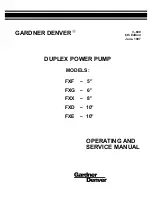
6
GA02307_002_C0 - 11/2016 - © Leybold
Description
1
Description
SOGEVAC
®
pumps are designed for pumping of inert gases in the range
of rough vacuum, between atmospheric pressure and ultimate pressure of
the pump.
When removing condensable vapours, a gas ballast valve must be installed.
1.1 Principle of operation
The SOGEVAC
®
pumps SV200 BR2 are single-stage oil-sealed rotary vane
vacuum pumps.
The anti-suckback valve, gas ballast valve (optional), exhaust filter, oil return
circuit and oil cooling oil are integrated functional elements. The pumps are
driven by a directly flanged motor.
The rotor (7/88), mounted eccentrically in the pump cylinder (7/83), has three
vanes which divide the pump chamber into several compartments. The
volume of each changes periodically with the rotation of the rotor.
As the rotor rotates, the intake portion of the pumping chamber expands and
sucks gas thru the intake port. The gas passes through the dirt trap and the
open anti-suckback valve (7/54) and enters the pump chamber. As the rotor
rotates further, the vane separates part of the pump chamber from the intake
port. This part of the pump chamber is reduced, and the gas is compressed.
At slightly above atmospheric pressure the gas is expelled from the chamber
via the exhaust valve (6/28).
Oil injected into the pump chamber serves to seal, lubricate and cool the
pump.
The oil entrained with the compressed gas is coarsely trapped in the oil case
(6/27) by deflection. Then fine filtering occurs in the exhaust filter elements
(6/29). The proportion of oil in the exhaust gas is thus reduced below the
visibility threshold (over 99.9 % entrapment rate).
Oil trapped in the exhaust filters is returned to the inlet chamber via an oil
return line (6/11).
To prevent gas flowing at atmospheric pressure from the oil reservoir into the
intake port, the oil return line is controlled by a float valve.
The oil cycle is maintained by the pressure difference existing between the oil
case (pressure above or equal atmospheric pressure) and the intake port
(pressure below atmospheric pressure). One part of the oil is taken from the
oil reservoir (6/27) and flows via the oil filter (6/25) to the bearing points of the
rotor and to the pump chamber. The other part of oil injected in the pump
does not run through the oil filter. So, if the oil filter is accidently completely
clogged, lubrification will be assured through the second circuit with enough
quantity of oil to guarantee the good mechanical running of the pump.
However, in that case, the pump will not reach anymore its specific end
pressure. That will often indicate that oil is polluted and/or oil filter is clogged.
Summary of Contents for SOGEVAC SV 200 BR2
Page 36: ... 36 GA02307_002_C0 11 2016 Leybold Spare parts fig 6 SV200 ...
Page 38: ... 38 GA02307_002_C0 11 2016 Leybold Spare parts fig 7 SV200 ...
Page 40: ... 40 GA02307_002_C0 11 2016 Leybold Spare parts fig 7 SV200 ...
Page 43: ... 43 GA02307_002_C0 11 2016 Leybold EC Conformance Declaration ...







































